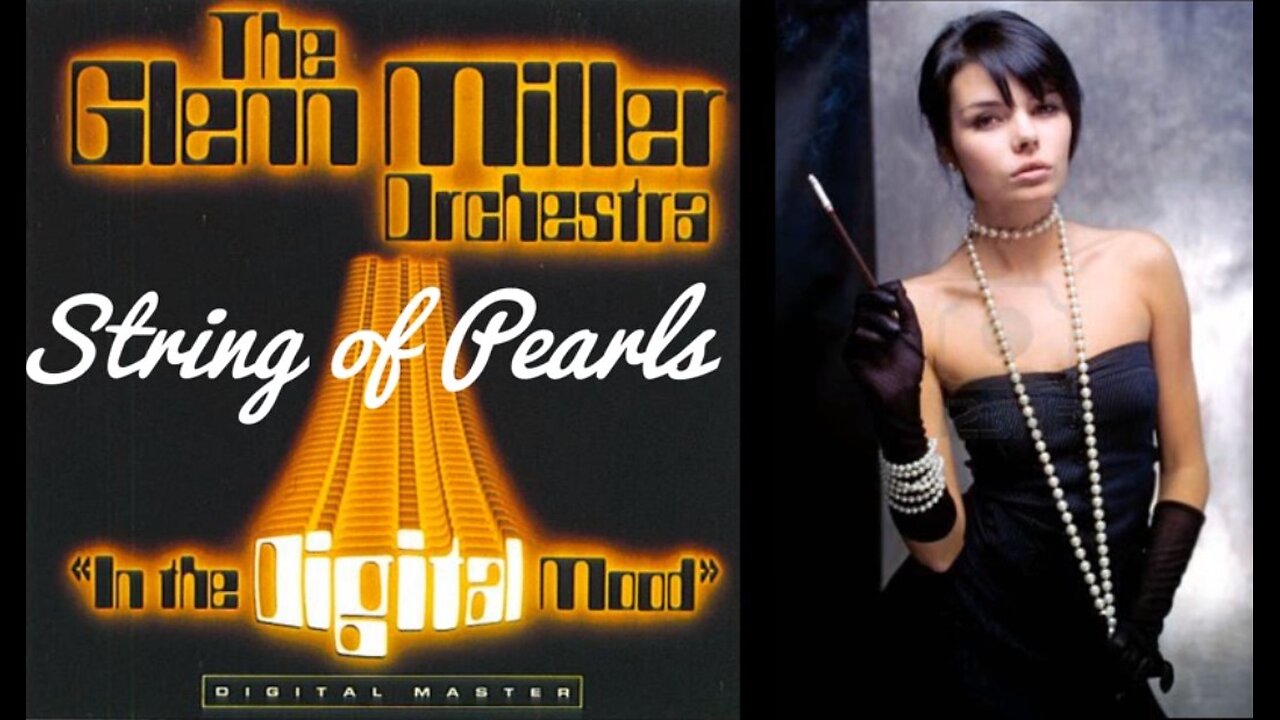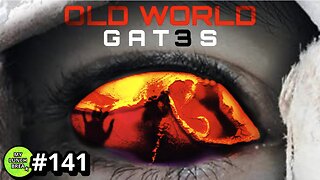Premium Only Content

Afrikitty presents: The Seduction of Big Band Swing King, Mr. GLENN MILLER!
This video was made using Magix Movie Edit Pro 17 HD.
Alton Glen "Glenn" Miller (1 March 1904[citation needed]; disappeared 15 December 1944; declared dead 16 December 1945) was an American big band conductor, arranger, composer, trombone player, and recording artist before and during World War II, when he was an officer in the US Army Air Forces. His civilian band, Glenn Miller and His Orchestra were one of the most popular and successful bands of the 20th century and the big band era. His military group, the Major Glenn Miller Army Air Forces Orchestra, was also popular and successful.
Glenn Miller and His Orchestra was the best-selling recording band from 1939 to 1942. Miller's civilian band did not have a string section as his military unit did, but it did have a slap bass in the rhythm section. It was also a touring band that played multiple radio broadcasts nearly every day. Their best-selling records include Miller's theme song – "Moonlight Serenade" – and the first gold record ever made, "Chattanooga Choo Choo". The following tunes are also on that best-seller list: "In the Mood", "Pennsylvania 6-5000" (printed as "Pennsylvania Six-Five Thousand" on record labels), "A String of Pearls", "Moonlight Cocktail", "At Last", "(I've Got a Gal In) Kalamazoo", "American Patrol", "Tuxedo Junction", "Elmer's Tune", "Little Brown Jug", and "Anvil Chorus". Including "Chattanooga Choo Choo", five songs played by Miller and His Orchestra were number one hits for most of 1942 and can be found on the List of Billboard number-one singles of 1942. In four years, Miller scored 16 number one records and 69 top 10 hits, more than Elvis Presley and the Beatles in their careers. His musical legacy includes multiple recordings in the Grammy Hall of Fame. His work has been performed by swing bands, jazz bands, and big bands worldwide for over 75 years.
Miller is considered to be the father of the modern US military bands. In 1942, he volunteered to join the US military to entertain troops during World War II and ended up in the US Army Air Forces. Their workload was just as heavy as the civilian band's had been. With a full string section added to a big band, the Major Glenn Miller Army Air Forces Orchestra was the forerunner of many US military big bands.
Miller went missing in action (MIA) on December 15, 1944, on a flight over the English Channel. In keeping with standard operating procedure for the US military services, Miller was officially declared dead a year and a day later. An Army investigation led to an official finding of death (FOD) for Miller, Norman Baessell, and John Morgan, all of whom died on the same flight. All three officers are listed on the Tablets of the Missing at Cambridge American Cemetery and Memorial in Cambridge, England. Since his body was not recoverable, Miller was allowed to have a memorial headstone placed at the US Army-operated Arlington National Cemetery in Arlington, Virginia. In February 1945, he was posthumously awarded the Bronze Star Medal.
Early life and career
The son of Mattie Lou (née Cavender) Miller and Lewis Elmer Miller, Alton Glen Miller was born in Clarinda, Iowa. He added the second n to "Glenn" during high school. Like his father (Lewis Elmer) and his siblings (Elmer Deane, John Herbert and Emma Irene), Miller went by his middle name, Glenn. As Dennis Spragg of the Glenn Miller Archives confirms, "Miller's use of his first name, Alton, was necessary for legal and military purposes, which is logically why it shows up in formal documents such as his military documents, driver’s licenses, tax returns, etc." He is listed as Alton G. Miller in the Army Air Forces section of the Tablets of the Missing in Cambridge American Cemetery and Memorial in Cambridge, England. His name is engraved as Major Alton Glenn Miller, US Army (Air Corps) on his Government-issued (G.I.) memorial headstone in Memorial Section H at Arlington National Cemetery in Arlington, Virginia. His last military unit has a memorial tree in section 13 on Wilson Drive. The American Holly was dedicated on December 15, 1994, the 50th anniversary of Miller's death, for the veterans of the Major Glenn Miller Army Air Forces Orchestra.
He attended grade school in North Platte in western Nebraska. In 1915, his family moved to Grant City, Missouri. Around this time, he had made enough money from milking cows to buy his first trombone and played in the town orchestra. He played cornet and mandolin, but he switched to trombone by 1916.
In 1918, Miller and his family moved to Fort Morgan, Colorado, where he went to Fort Morgan High School. In the fall of 1919, he joined the F.M.H.S. Maroons, the high school football team that won the Northern Colorado American Football Conference in 1920. He was named Best Left End in Colorado in 1921. For two years, Miller was one of the editors of his own high school yearbook, "Memories". In each of the yearbooks he edited, his name was spelled both Glen with one n, and Glenn with a double n.
During his senior year, he became so interested in dance band music that he formed a band with some classmates. The high school orchestra was an after school activity, but he played there too. For a time, classes in harmony, piano, violin, and music appreciation were full, but classes were discontinued. However, by the time he graduated from high school in 1921, he had decided to become a professional musician. He missed his own graduation because he was performing out of town. His mother gladly received his diploma for him.
In 1923, Miller entered the University of Colorado at Boulder, where he joined Sigma Nu fraternity. He spent most of his time away from school, attending auditions and playing any gigs he could get, including with Boyd Senter's band in Denver. After failing three out of five classes, he dropped out of school to pursue a career in music. He failed Harmony.
In New York City, he studied the Schillinger system with Joseph Schillinger, under whose tutelage he composed "Miller's Tune". Miller arranged that tune for big band and renamed it. It became his signature theme, "Moonlight Serenade".
In 1926, Miller toured with several groups, landing a good spot in Ben Pollack's group in Los Angeles. He also played for Victor Young, which allowed him to be mentored by other professional musicians. In the beginning, he was the main trombone soloist of the band, but when Jack Teagarden joined Pollack's band in 1928, Miller found that his solos were cut drastically. He realized that his future was in arranging and composing.
He had a songbook published in Chicago in 1928 entitled 125 Jazz Breaks for Trombone by the Melrose Brothers. During his time with Pollack, he wrote several arrangements. He wrote his first composition, "Room 1411", with Benny Goodman, and Brunswick Records released it as a 78 rpm record under the name "Benny Goodman's Boys".
In 1928, when the band arrived in New York City, he sent for and married his college sweetheart, Helen Burger. He was a member of Red Nichols' orchestra (Red Nichols and his Five Pennies) in 1930, and because of Nichols, he played in the pit bands of two Broadway shows, Strike Up the Band and Girl Crazy. That band included Benny Goodman and Gene Krupa.
During the late 1920s and early 1930s, Miller worked as a freelance trombonist in several bands. On a March 21, 1928, Victor Records session, he played alongside Tommy Dorsey, Benny Goodman, and Joe Venuti in the All-Star Orchestra directed by Nat Shilkret. He arranged and played trombone on several significant Dorsey brothers sessions for OKeh Records, including "The Spell of the Blues", "Let's Do It", and "My Kinda Love", all with Bing Crosby on vocals. On November 14, 1929, vocalist Red McKenzie hired Miller to play on two records: "Hello, Lola" and "If I Could Be With You One Hour Tonight". Beside Miller were saxophonist Coleman Hawkins, clarinetist Pee Wee Russell, guitarist Eddie Condon, and drummer Gene Krupa.
In the early to mid-1930s, Miller worked as a trombonist, arranger, and composer for the Dorsey Brothers, first, when they were a Brunswick studio group and later, when they formed an ill-fated orchestra. Miller composed the songs "Annie's Cousin Fanny", "Dese Dem Dose", "Harlem Chapel Chimes", and "Tomorrow's Another Day" for the Dorsey Brothers Band in 1934 and 1935.
In 1935, he assembled an American orchestra for British bandleader Ray Noble, developing the arrangement of lead clarinet over four saxophones that became a characteristic of his big band. Members of the Noble band included Claude Thornhill, Bud Freeman, and Charlie Spivak.
Miller made his first movie appearance in The Big Broadcast of 1936 as a member of the Ray Noble Orchestra performing "Why Stars Come Out at Night". The film included performances by Dorothy Dandridge and the Nicholas Brothers, who would appear with Miller again in two movies for Twentieth Century Fox in 1941 and 1942.
In 1937, Miller compiled several arrangements and formed his first band. After failing to distinguish itself from the many bands of the time, it broke up after its last show at the Ritz Ballroom in Bridgeport, Connecticut on January 2, 1938.
Benny Goodman said in 1976:
In late 1937, before his band became popular, we were both playing in Dallas. Glenn was pretty dejected and came to see me. He asked, "What do you do? How do you make it?" I said, "I don't know, Glenn. You just stay with it."
Success from 1938 to 1942
Main article: Glenn Miller Orchestra
The Glenn Miller Orchestra
Discouraged, Miller returned to New York. He realized that he needed to develop a unique sound and decided to make the clarinet play a melodic line with a tenor saxophone holding the same note, while three other saxophones harmonized within a single octave. George T. Simon discovered a saxophonist named Wilbur Schwartz. Miller hired Schwartz but had him play lead clarinet instead of the saxophone. According to Simon, "Willie's tone and way of playing provided a fullness and richness so distinctive that none of the later Miller imitators could ever accurately reproduce the Miller sound." With this new sound combination, Miller found a way to differentiate his band's style from that of many bands that existed in the late 1930s.
Miller talked about his style in the May 1939 issue of Metronome magazine. "You'll notice today some bands use the same trick on every introduction; others repeat the same musical phrase as a modulation into a vocal ... We're fortunate in that our style doesn't limit us to stereotyped intros, modulations, first choruses, endings, or even trick rhythms. The fifth sax, playing the clarinet most of the time, lets you know whose band you're listening to. And that's about all there is to it.
For more information on Glenn Miller, please go to his Wikipedia page at https://en.wikipedia.org/wiki/Glenn_Miller
-
 LIVE
LIVE
Akademiks
3 hours agoWar in RAT-LANTA. Young Thug vs Gunna vs Ralo vs YSL MONDO. Who Will Le Bebe Pick. FINAL CRASHOUT!
7,906 watching -
 LIVE
LIVE
MYLUNCHBREAK CHANNEL PAGE
23 hours agoFault Lines are GATES - Pt 3
333 watching -
 LIVE
LIVE
Sgt Wilky Plays
1 hour agoRumble Gaming Bad Company Presents WARZONEPALOOZA
110 watching -
 LIVE
LIVE
Rallied
48 minutes agoSolo Challenges ALL DAY
111 watching -
 17:54
17:54
Nate The Lawyer
4 hours agoChicago Mayor’s $600M Migrant Spending Leaves City $1.1B Budget CRISIS.
2.19K22 -
 LIVE
LIVE
GritsGG
5 hours agoRumble Customs! 3515 Ws! 🫡!
213 watching -
 LIVE
LIVE
cosmicvandenim
14 hours agoVAN DENIM x RALLIED & GRITS | Team 6: Denim Grit | Warzonepalooza Tournament
186 watching -
 LIVE
LIVE
GamerGril
1 hour ago💕 The Evil Within 2 💕 | First Time Playthrough | Backseat Gaming Encouraged
57 watching -
 1:03:57
1:03:57
Jeff Ahern
2 hours agoThe Saturday show with Jeff Ahern
3.15K3 -
 LIVE
LIVE
ZWOGs
1 hour ago🔴LIVE IN 1440p! - Sgt Wilky's WARZONEPALOOZA - Warzone Resurgence Tournament - Come Hang Out!
31 watching